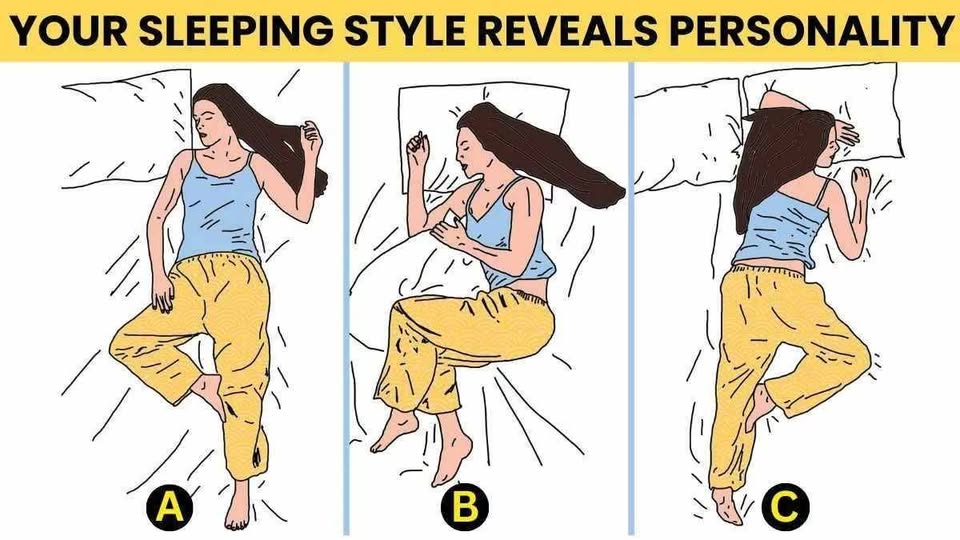How Your Sleeping Position Reveals If You’re Lazy
Did you know that the way you sleep can reveal more than just your comfort preferences? Your sleeping position can provide insight into your personality, energy levels, and even how hard you try in your daily life. Believe it or not, where and how you position your body at night might also say something about whether you are hardworking, lazy, or somewhere in between. Let’s dive into how different sleeping positions reflect your personality and potential laziness levels.
1. The Winner Who Never Stops
Sleeping Position: Sleeping in a very tight position, often curled up or in a tight ball.
What It Means: This position is often associated with people who feel like they are carrying the weight of the world on their shoulders. These sleepers tend to be hardworking, persistent, and may be overly focused on others’ needs. While they are not lazy by any means, they might push themselves too hard and overexert their energy, sometimes neglecting their own needs. This type of person is often determined, perhaps to a fault.
Lazy Indicator? ❌ Not lazy! These individuals are driven, but they might be burning themselves out. It’s important for them to take breaks and learn to listen to their body.
2. The Fetal Position (Curled Up on Your Side)
Sleeping Position: Curled up on your side, with your knees drawn toward your chest and arms around your body.
What It Means: The fetal position is common among introverts and people who seek comfort, security, and emotional protection. It suggests that the person may have a need to feel safe or shielded from the world, which might indicate some hesitation or emotional vulnerability. This sleeping style is often associated with people who prefer to avoid conflict or responsibility, retreating inwardly for rest and reflection.
Lazy Indicator? ⚖️ Maybe. This position may reflect a sense of hesitation or avoidance rather than outright laziness. It’s more about emotional needs than a lack of motivation.
3. The Log Position (Lying Straight on Your Side)
Sleeping Position: Lying straight on your side with both arms and legs relatively extended and close to the body.
What It Means: People who sleep in the log position are often sociable, easygoing, and approachable. They enjoy balance in life and typically have a calm demeanor. However, if the sleeper becomes too stiff or rigid in this position, it could hint at a lack of motivation or a passive approach to challenges. They are disciplined but might become too set in their ways, avoiding change or growth in the long term.
Lazy Indicator? ❌ Not lazy! These individuals tend to be disciplined and sociable, but the position could indicate a tendency toward rigidity or a lack of initiative when things get uncomfortable.
4. The Freefall Position (Sleeping on Your Stomach, Arms Out)
Sleeping Position: Sleeping on your stomach with your arms stretched out and your head turned to one side.
What It Means: People who sleep in the freefall position tend to be adventurous, carefree, and sometimes rebellious. They may enjoy a sense of freedom but often avoid responsibilities or stress. While this position can indicate an adventurous spirit, it can also be a sign of someone who procrastinates, avoids pressure, or shirks responsibility. It’s a “live in the moment” type of attitude, but one that might lead to neglecting long-term tasks or goals.
Lazy Indicator? ✅ Often! The freefall position often indicates avoidance of pressure, stress, or effort. While the person may be fun-loving, they might be prone to procrastination and avoiding responsibilities.
5. Tossing and Turning (Constantly Changing Positions)
Sleeping Position: Constantly shifting and changing positions throughout the night.
What It Means: People who toss and turn a lot might have trouble settling down or finding peace, both mentally and physically. This could be a sign of restlessness, indecision, or a lack of direction in life. Tossing and turning may reflect a person who has difficulty committing to one idea, plan, or course of action, leading to frequent changes in direction. While this doesn’t necessarily equate to laziness, it may indicate an inability to focus or stick with a decision.
Lazy Indicator? ⚖️ Possibly! While it’s more about indecision and restlessness, this could be a sign of procrastination or lack of commitment, which can lead to laziness if not addressed.
Final Thought:
Your sleep position alone doesn’t define whether you’re lazy or hardworking. However, certain positions may reveal tendencies toward certain personality traits, such as being hardworking, avoiding responsibility, or procrastinating. If you sleep like a starfish or in the freefall position, it could suggest a more laid-back, procrastination-prone personality, whereas a tight, curled-up position or straight side position suggests a person who is hardworking or disciplined but may need to find balance in their life.
Q&A About Sleep Positions and Personality:
Q1: Does my sleeping position mean I’m lazy if I sleep on my stomach?
A1: Not necessarily. While the freefall position (on your stomach with arms out) can indicate avoidance of responsibility, it doesn’t directly equate to laziness. It’s more about a carefree attitude, which can sometimes lead to procrastination but doesn’t necessarily mean you avoid work or effort entirely.
Q2: Why do I change positions so much while I sleep?
A2: Constant tossing and turning can reflect a restless mind or body. It may indicate indecision or a lack of direction, both mentally or emotionally. It’s not necessarily a sign of laziness, but it might suggest you have trouble finding clarity or committing to decisions in your life.
Q3: How can I stop procrastinating if I tend to sleep in a “freefall” position?
A3: If you find that your carefree, “live-in-the-moment” attitude leads to procrastination, try setting clearer goals and timelines for yourself. Structuring your day and committing to smaller, manageable tasks might help combat the avoidance of responsibilities. Consider seeking out more routines or support systems that encourage follow-through.
Q4: Can my sleeping position change my personality?
A4: Your sleep position is influenced by your current emotional and mental state, so while it doesn’t define your personality, it can reflect it. If you find that your sleep position is aligned with procrastination or laziness, making efforts to address those traits during the day might help shift your sleeping habits over time.
Q5: What does it mean if I sleep with my arms above my head?
A5: Sleeping with your arms above your head can indicate a sense of openness and vulnerability. It may suggest that you are relaxed and confident, or you might be someone who feels free to express yourself emotionally. It can also point to a person who is comfortable being exposed and is typically easy-going and unafraid to show who they truly are.
Conclusion:
Your sleep position can reveal a lot about your personality and habits, including whether you lean toward laziness or industriousness. However, it’s important to remember that your sleep position is just one piece of the puzzle. Whether you’re a tight curled-up sleeper or someone who changes positions constantly, understanding how you sleep can help you reflect on your habits and behaviors, potentially leading to more mindful decisions in your waking life. So, next time you wake up, take note of your sleep position—it might be trying to tell you something about your personality!

